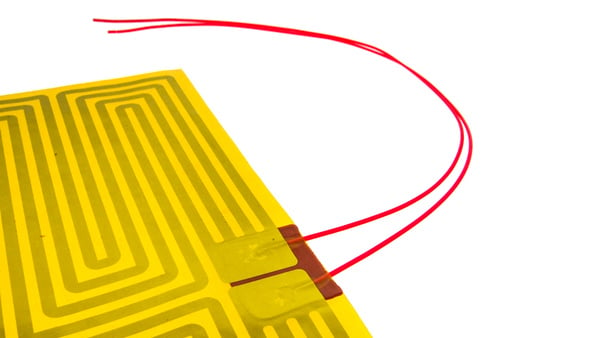Whether used in the aerospace industry to de-ice equipment, or the food industry to bring ingredients up to a suitable temperature, flexible heaters provide the right amount of generated heat based on the application. These types of heaters can be attached to smooth, bulky and curved equipment in different sizes and functions.
Selecting the right type of flexible heater ensures obtaining consistent and stable heat without causing damage or failure of the application. Let's look at the best uses of three common flex heaters: polyimide heaters, silicone heaters and polyester heaters.
Polyimide Flexible Heaters
Polyimide flex heaters consist of an etched foil element layer that is sandwiched between two layers of polyimide film using a FEP adhesive or an acrylic adhesive. The flexible heater is extremely thin, as it can reach a thickness as low as 0.007". The heater has a watt density of 2.5 up to 50W/in2. Benefits of polyimide heaters are:
- Low temperature threshold of -320°F
- Can handle temperatures up to 395°F
- Resistive properties as it cannot crack or tear
- Resistant to chemicals, radiation, and fungus
- Minimal outgassing in vacuum environments
- Uniform thermal distribution and stability
- Good thermal transfer capabilities

Example of a polyimide flexible heater.
Uses of Polyimide Flexible Heaters
Due to its thin and lightweight capabilities, polyimide flexible heaters can be used on applications where extra weight can be an issue to working parts. It can also be placed on equipment where there is minimal space available. So, there is no need for any design finishes for the application to accommodate the flexible heater. The flexible nature of polyimide makes the heater suitable for curved and irregular surfaces without worrying about the heater being rubbed off.
Another reason that a polyimide heater may be desired, is when a manufacturer does not want any trapped gasses escaping from the molecular structure of the created heater materials during extended use. These trapped gasses can impact the use of sensors in a closed environment. Polyimide contains very little trapped gas.
Possessing good heat transfer, polyimide heaters are often used for applications in rugged environments where durability is required. They are found in aerospace, food service, military, and medical industries. The heater can also be used for both indoor and outdoor environments.
Silicon Rubber Flexible Heaters
Manufacturers turn to silicon rubber flexible heaters for general application purposes. The element consists of wire wound or etched foil that is vulcanized between silicon rubber insulating materials. This heater is thicker than a polyimide flex heater, as a wire wound silicone heater can be 0.03", while an etched foil silicon heater can have an average thickness of 0.056". The watt density of this heater can reach up to 60 W/in2. Some benefits include:
- Maximum temperature range of 455-500°F
- Wards off mechanical damage and abrasion due to thicker silicon material
- Can be vulcanized onto components
- Suitable for wet and outdoor environments as it acts as a moisture barrier
- Appropriate for flat surfaces
- Used when needing multiple watt densities
![]()
Example of a silicon rubber flexible heater.
Uses for Silicon Rubber Flexible Heaters
A silicon flexible heater can be placed on flat surfaces as well as for applications where a large heater is needed that offers multiple watt densities. It can also handle higher temperatures while in humid and outdoor environments.
The thickness of the silicon rubber provides added durability and dimensional stability, although the thermal transfer is delayed. Lower watt densities are not suitable for applications that require a faster thermal ramp up, as a manufacturer must select a higher 10 W/in2 or more if a quicker thermal transfer is required.
Silicon rubber flexible heaters provides cost savings, as they are most often used for general and industrial applications. It is also suitable for applications when vulcanization of the heater is desired when attaching the heater directly to the component.
Polyester Flexible Heaters
Polyester flex heaters are custom made for applications that require lower heat transfer. They possess elements made out of etched foil, indium titanium oxide inks, or wire wound as the elements are placed within polyester layers that can be transparent for certain applications. They can have a watt density of about 20 W/in2 (0.3W/cm2) and can have a thickness as low as 0.007". Here are several benefits of polyester flexible heaters:
- Low temperature applications of 220°F
- Uniform heat transfer capabilities
- Flexible and lightweight for applications
- Sometimes more economical than silicone rubber heaters

Example of a polyester flexible heater.
Uses of Polyester Flexible Heaters
Polyester heaters are often used for smaller applications where a lower heat temperature is desired. These flexible heaters typically provide a temperature of 221°F. Manufacturers often use these heaters where the application would be damaged at moderate to high heat or to remove a buildup of moisture or ice that may accumulate on components, such as de-icing mirror surfaces, warming batteries, keeping food ingredients at a desired temperature in restaurants, warming fish aquariums, and inside coffee makers to warm up cups.
The flexibility and lightweight nature of polyester flex heaters makes them suitable for applications where increased weight and irregular curved surfaces would be major issues. The etched foil polyester heaters possess a maximum element width of 590 mm, making them a good choice for smaller applications. In addition, this heater can be customized so that it is transparent when an aesthetic appearance is desired for the application.
Summary
Applications can vary based on their operation, size, surface structure, and environmental conditions. When trying to decide on the right flexible heater, manufacturers will need to perform a comprehensive evaluation of the equipment's functions at the design phase or review existing equipment when it is in use. Then they will be able to match the right heater based on their specific requirements.
Here is a brief breakdown on the types of applications each heater is suitable for:
- Low heat temperature requirements: polyester heaters
- Offers highest maximum temperatures: rubber silicone heaters
- Used in environmental temperatures of -100 to -300°F: polyimide heaters
- Uniform heat transfer: polyimide and polyester heaters
- Good heat thermal transfer: polyimide heaters
- Suitable for outdoor and wet conditions: rubber silicone heaters
- Lightweight and flexible heaters: polyester and polyimide heaters
- For large, flat surfaces: rubber silicone heaters
- For curved and irregular surfaces: polyimide and polyester surfaces
- Aesthetically pleasing appearance is necessary: transparent polyester heaters
- Resistant to chemicals: polyimide and rubber silicone heaters
- Vacuum settings where outgassing is an issue: polyimide heaters
- Can be vulcanized into place: rubber silicone heaters
- Most cost effective: polyester heaters
Here at Epec Engineered Technologies, we provide polyimide, silicon rubber, and polyester heaters in the materials, heat settings, and sizes that will work for the application. To learn more about our customization capabilities for flexible heaters, contact our technical staff today.
Key Takeaways:
- Polyimide Flexible Heaters: Ideal for lightweight applications requiring high flexibility, durability, and chemical resistance. With a temperature range from -320°F to 395°F, these heaters offer excellent heat transfer and minimal outgassing, making them suitable for aerospace, military, and medical applications.
- Silicone Rubber Flexible Heaters: Best for general industrial applications, these heaters withstand higher temperatures up to 500°F, provide moisture resistance for outdoor use, and can be vulcanized directly onto components for permanent attachment. However, they have a delayed thermal transfer due to their thicker structure.
- Polyester Flexible Heaters: Designed for low-temperature applications (up to 220°F), these heaters are lightweight, flexible, and economical. They are commonly used in food service, battery warming, and de-icing applications, and can be made transparent for aesthetic purposes.
- Choosing the Right Heater: Polyimide and polyester heaters are best for curved and irregular surfaces, while silicone rubber heaters are ideal for large, flat surfaces. If chemical resistance or vacuum outgassing concerns exist, polyimide heaters are the best choice.
- Environmental & Cost Considerations: Silicone rubber heaters perform well in wet and outdoor conditions, polyimide heaters handle extreme cold (-100 to -300°F), and polyester heaters are the most cost-effective solution for applications that require low-temperature heating.
















